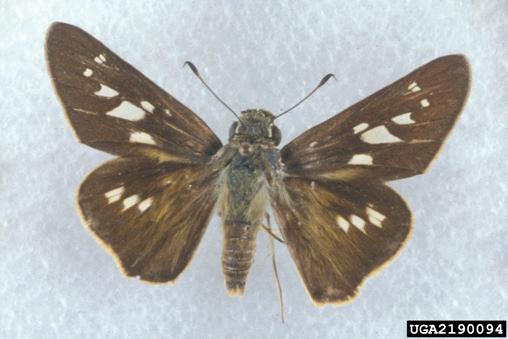
7 minute read
Pest 411 Larger canna leafroller
Larger canna leafroller
A major insect pest of canna lily
Advertisement
by Shimat V. Joseph, Assistant Professor, Department of Entomology, University of Georgia
Herbert A. 'Joe' Pase III, Texas A&M Forest Service, Bugwood.org,
The larger canna leafroller (LCLR),

Calpodes ethlius (Stoll), is a major pest of canna lily in Georgia. Native to Mexico, Central America, and the northern part of the South American continent, this pest is well established in the southern states, including Georgia.
This pest is also referred to as the Brazilian skipper, the canna butterfly, or the arrowroot butterfly.
Biology
Charles T. and John R. Bryson, Bugwood.org The LCLR adult Fig. 1. Larger canna leaf roller butterfly. is a medium-sized, brownish skipper butterfly (Fig. 1). The females (22-27 mm in length) are larger than the males (23 to 24 mm). The first pair of wings has five clear spots and yellow-colored hairs on the lower margin. The second pair of wings has three clear spots.
Similar to other skipper butterflies, LCLRs are erratic and fast fliers and consume nectar from the flowers.
In Georgia, adults start laying eggs in midMay and undergo multiple generations through the summer. The attacks on plants persistently continue until temperatures cool down in the fall.
The eggs are about 1 mm in diameter and are visible by the naked eye (Fig. 2). Pale green colored eggs are laid singly on the upper and lower leaf surface of canna. Sometimes, several eggs can be found on a single leaf. A day after laying, the eggs turn a pinkish color. A few days later, the eggs hatch.
Feeding
They initially feed on the leaf margin creating a leaf flap (Fig. 3A). Then the larva ties the leaf flap with the rest of the leaf using silken strands. A few days later, the larva systematically rolls the leaf by tying from a smaller roll to rolling the entire leaf (Fig. 3B and C). The caterpillar feeds within the roll and pushes out the frass pellets (excrements) from the leaf rolls. The leaf roll provides shelter and protection from the sun and natural enemies.
Development
The greenish, naked, or transparent larva has a distinctively large head capsule (Fig. 4). Initially, the head is black but turns into an orange color with black triangular marks in the later stages (fourth and fifth stage larva) of larval development (Fig. 4C). Because the caterpillar feeds on green leaves, the color of the caterpillar appears green. The larvae molt five times before transforming to pale green pupae within the leaf roll.
Host plants and damage
LCLR mostly attacks plant species within the Cannaceae family. The only other family where LCLR was found is West Indian arrowroot, Maranta arundinacea L.
The leaf rolling can cause severe damage to canna plants as most of the leaves are rolled. Any new shoots that emerge of the rhizome are severely attacked, and plants hardly produce any flowers if not managed. LCLR also feed on the emerging flowers (Fig. 3D). The entire plant appears completely beaten and battered (Fig. 5).
Monitoring and management
Scouting the leaves for young larvae as they begin to roll the leaves is critical (Fig. 3A). The larvae developing inside the roll can be mechanically killed by squishing with fingers. However, it can be overwhelming once the infestation becomes severe.
Previously, parasitic wasps, Brachymeria incerta attacking LCLR pupae and Xenufens ruskini, and Trichogramma minutum attacking LCLR eggs have been reported from Florida. However, it is not clear if those parasitic wasps are active in Georgia. Moreover, significant suppression of the LCLR population can be challenging through natural enemies when pest numbers are high.
Two studies were conducted to determine the host plant resistance of cultivars to LCLR. These studies did not identify any cultivars truly resistant to this pest but observed less egg laying on green-leaved canna varieties than red-leaved varieties. Similarly, more egg-laying and damage from larval feeding was observed on red or orange flower varieties than other varieties. In Georgia, the ‘Maudie Malcom’ variety appears to be less susceptible to LCLR attack.
A

Shimat Joseph, University of Georgia Fig. 2. Larger canna leaf roller egg on a leaf.
The use of Bt (Bacillus thuringiensis) insecticide can give some control if the caterpillars are mostly in earlier stages. Any contact insecticides such as pyrethroids (e.g., bifenthrin) can reduce the LCLR population, including larger caterpillars. Adequate insecticide coverage, meaning more water than usual (high water volume application), is necessary to control as caterpillars are hidden inside the rolls. A low
B C D


Shimat Joseph, University of Georgia Fig. 3. Larger canna leaf roll damage. (A) symptom caused by early larva by stitching the flag leaf , (B and C) feeding after rolling the leaf, and (D) feeding damage on the developing flowers.


A B
A & B: Shimat Joseph, University of Georgia,
C: Herbert A. 'Joe' Pase III, Texas A&M Forest Service, Bugwood.org Fig. 4. Larger canna leaf roller caterpillar. Fig. 5. Extensive feeding damage after larger canna leaf roller attack.

C
water volume application may not reach those hidden caterpillars. The plants treated with insecticides will recover and start producing flowers. Repeated applications (two or three times) during summer may be necessary when the pest pressure is very high. Please carefully read the insecticide label before use, as the insecticide label is the law.

Shimat Joseph, University of Georgia


ugaurbanag.com/certification
The secret of our strength isYOU!
As a member of Georgia’s premier association for green industry professionals, you have the power to make your industry stronger.
Networking & marketing










Meet industry leaders and get your product or service in front o of f o ou ur r g grorow wining g membership
Education










Diverse educational opopp porortutun nitities,ies, from monthly dinner meetings to workshops that help you meet licensing requiremrequiremenent ts s
Legislative support
State and national governmental affairs/legislative monitoring
UAC Magazine
Six issues/year packed with the information you need on business, industry, and urban ag topics
Trade show & field days
The latest trends, newest equipment, and cutting edge resreseaearcrch,h, a allll brought together for you
Judges Choice Awards
From design/build to maintenance to community s serviervicece t to o g grereenen innovations to safety, UAC awards programs give you a chance to shine and be recognized
PLUS:
Reduce your costs
UAC Workers Compensation and Health Benefits programs through WS Pharr/Snellings Walters offer competitive rates and outstanding customer service.
Advocate.Educate.Promote.
PO Box 3400 Duluth GA 30096 | P: 706.750.0350 | E: office@georgiauac.com | urbanagcouncil.com Tell a colleague about Georgia UAC today!










